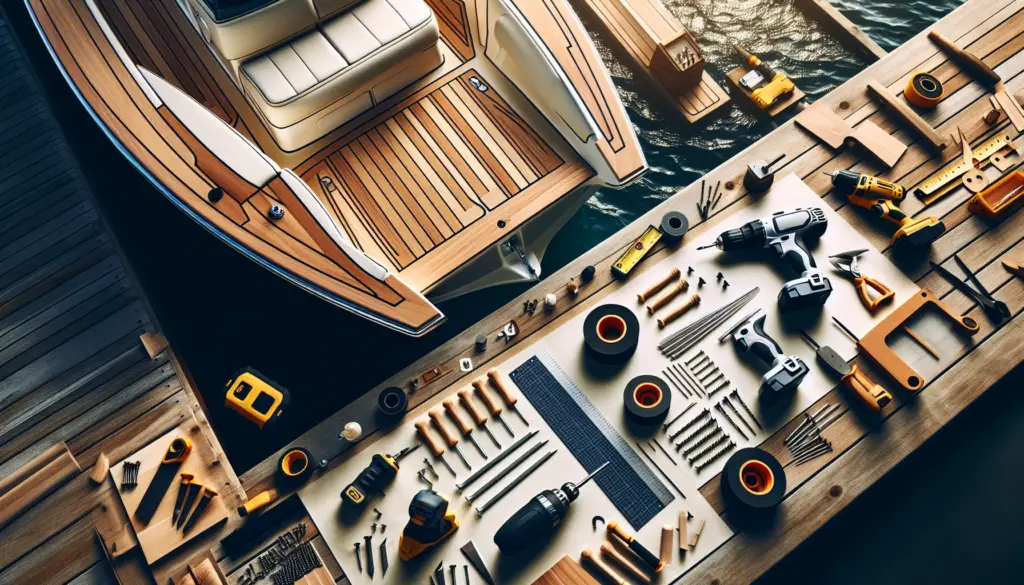So, you’ve taken the plunge and bought yourself a beautiful boat. Congratulations! Now, you’re probably thinking about ways to make it truly your own, to add those personal touches that will make it stand out from the rest. One of the best ways to do that is by adding custom decking to your boat. Not only will it enhance the overall aesthetic appeal, but it can also improve functionality and comfort. In this beginner’s guide, we’ll walk you through the basics of adding custom decking to your boat, from selecting the right materials to installation techniques. So, let’s get started on transforming your boat into a stylish and unique vessel that reflects your personality and taste.
Step 1: Choosing the Right Decking Material
When it comes to adding custom decking to your boat, choosing the right material is crucial. There are several different types of decking materials available, each with its own unique characteristics and advantages. Understanding these materials and considering their pros and cons will help you make an informed decision.
One common type of decking material is wood. Wood is a classic and versatile option, offering a natural and warm aesthetic. However, it does require regular maintenance to prevent rotting, warping, or fading due to exposure to the elements.
Another popular choice is composite decking. Made from a combination of wood fibers and recycled plastic, composite decking offers the look and feel of real wood without the need for extensive maintenance. It is resistant to rot, insects, and fading, making it a durable option for boat decks.
Aluminum decking is a lightweight and corrosion-resistant option that is becoming increasingly popular among boat owners. It is low-maintenance and offers excellent durability, making it suitable for both freshwater and saltwater environments.
Finally, there is also PVC decking, which is made from synthetic materials. PVC decking is highly resistant to moisture, insects, and UV rays, making it a long-lasting and low-maintenance choice. It is available in a variety of colors and textures, allowing you to achieve the desired look for your boat’s deck.
Consider your boat’s specific needs, the level of maintenance you are willing to commit to, and your desired aesthetic when choosing the right decking material.
Step 2: Taking Accurate Measurements
Before you can start adding custom decking to your boat, it is important to take accurate measurements of your boat’s deck. This step is crucial to ensure that you have the right amount of decking material and that it fits perfectly.
Start by measuring the dimensions of your boat’s deck, taking into account any curves or irregularities. Use a measuring tape or a laser distance measurer to get precise measurements. Be sure to measure the length, width, and any other dimensions that are relevant to your deck design.
It is also important to account for any gaps or spacing you want between the decking boards. This will help you calculate the amount of decking material needed.
If your boat’s deck has any curves or angles, it is essential to measure them accurately. Use a flexible measuring tape or cardboard templates to capture the shape of the curves or angles.
Once you have all the measurements, calculate the amount of decking material needed. Most manufacturers provide guidelines on how much material you will need based on the dimensions of your deck. It is always a good idea to order slightly more material than you think you will need to account for any mistakes or waste.

Step 3: Preparing the Boat’s Deck
Before you can install the custom decking, you need to ensure that the boat’s deck is properly prepared. This involves removing any existing decking or materials, cleaning and sanding the deck surface, and ensuring the deck is structurally sound.
Start by removing any old or damaged decking. Use a pry bar or a screwdriver to carefully remove the fasteners and lift the old decking off the deck surface. Dispose of the old decking properly.
Once the deck is clear, thoroughly clean the surface to remove any debris, dirt, or mildew. Use a mild detergent and a scrub brush to scrub the deck surface. Rinse it thoroughly with water and allow it to dry completely.
Next, sand the deck surface to create a smooth and even base for the new decking material. Use a random orbital sander or sanding block with coarse sandpaper to remove any rough spots or imperfections. Finish with a finer sandpaper to achieve a smooth surface.
During this step, it is also important to inspect the deck for any signs of damage or rot. Repair or replace any damaged or rotten sections of the deck to ensure its structural integrity.
Step 4: Designing the Deck Layout
Designing the layout of your boat’s deck is a crucial step in the custom decking process. It involves considering the layout and functionality of the deck, determining the desired shape and size, and planning for any additional features or accessories.
Start by thinking about how you intend to use your boat’s deck. Do you need ample seating space? Are you planning to add a dining area or a bar? Consider the activities you will be doing on the deck and how you want the space to function.
Next, determine the desired shape and size of the deck. Take into account the measurements you took earlier and the available space on your boat. Consider the proportions and scale of your boat to create a deck layout that is visually appealing and functional.
If you plan to add any additional features or accessories, such as a bimini top or fishing rod holders, now is the time to incorporate them into your design. Take into consideration the necessary space and structural support for these features.
Sketch out your deck layout on paper or use a 3D design software to visualize the final result. This step will help you make any necessary adjustments or refinements before moving on to the installation phase.

Step 5: Installing the Deck Framework
The deck framework is the skeleton that supports the decking material and ensures its stability. Choosing the right framework material, measuring and cutting the pieces accurately, and securing the framework to the boat’s deck are key steps in the installation process.
Select a framework material that is suitable for your boat’s needs and the decking material you have chosen. Common framework materials include treated lumber, aluminum, or composite materials designed specifically for deck framing.
Start by measuring and cutting the framework pieces according to your deck layout. Use a circular saw or a miter saw to make precise cuts. Take extra care to ensure the cuts are accurate and fit together seamlessly.
Once the framework pieces are cut, lay them out on the boat’s deck according to your deck layout design. Secure the framework to the deck using appropriate fasteners, such as stainless steel screws or bolts.
During this step, it is important to ensure that the framework is level and securely attached to the boat’s deck. Use a level and a drill to make any necessary adjustments or reinforcements.
Step 6: Cutting and Fitting the Decking Material
With the deck framework in place, it’s time to cut and fit the decking material. Using the measurements you took earlier, cut the decking material to the appropriate size and shape.
Carefully lay the decking boards on the framework, ensuring proper alignment and fit. Depending on the type of decking material you have chosen, you may need to leave some spacing between the boards for expansion and contraction. Refer to the manufacturer’s guidelines for the recommended spacing.
If your boat’s deck has any curves or angles, it may be necessary to make adjustments to the decking material. This can be done by cutting the boards into smaller pieces or using a heat gun to reshape them to fit the contours of the deck.
Take your time during this step to ensure that the decking material is cut and fitted accurately. This will help achieve a professional and seamless finish.

Step 7: Fastening the Decking to the Framework
Securing the decking to the framework is an important step to ensure the stability and durability of your custom boat deck. The method of fastening will depend on the type of decking material you have chosen.
For wood or composite decking, stainless steel screws or hidden fasteners can be used to secure the boards to the framework. These fasteners should be spaced at regular intervals to ensure the decking is securely attached.
If you have chosen aluminum or PVC decking, they may come with their own specialized fastening system. Follow the manufacturer’s instructions to ensure proper installation.
During this step, it is important to pay attention to the spacing and alignment of the decking boards. Use spacers or a chalk line to ensure consistent spacing between the boards and maintain a straight and uniform appearance.
Step 8: Adding Finishing Touches
Now that the decking is securely installed, it’s time to add some finishing touches to enhance the aesthetics and functionality of your boat’s deck. Applying a protective sealant or finish to the decking will help protect it from the elements and extend its lifespan.
Choose a sealant or finish that is specifically designed for the type of decking material you have chosen. Follow the manufacturer’s instructions for proper application and drying times.
If slip resistance is a concern, consider adding non-slip surfaces or traction pads to the decking. These can provide extra safety, especially in wet or slippery conditions.
Additionally, you may want to install any desired accessories or fixtures, such as cup holders, storage compartments, or railing systems. Be sure to plan their placement during the design phase and follow the manufacturer’s instructions for proper installation.

Step 9: Testing and Inspecting the Deck
With the custom decking installed and finished, it is important to conduct thorough tests and inspections to ensure its stability and durability. Test the deck by walking on it and applying pressure to different areas. Pay attention to any signs of movement, instability, or squeaking.
Inspect the deck for any signs of damage or weakness, such as loose boards or fasteners. Check for any water pooling or drainage issues. Address any issues promptly to prevent further damage or safety hazards.
If you have any concerns or uncertainties during the testing and inspection process, consult a professional or seek advice from experienced boaters. Their expertise can help identify any potential issues and offer solutions.
Step 10: Regular Maintenance and Care
Maintaining your custom boat deck is essential to keep it in optimal condition and extend its lifespan. Establish a routine cleaning and maintenance schedule to ensure your deck remains in great shape.
Regularly clean the deck surface to remove dirt, debris, and saltwater residue. Use a mild detergent and a soft brush or sponge to scrub the deck gently. Rinse thoroughly with water to remove any soap residue.
Take steps to prevent water damage and sun fading by applying a protective sealant or finish annually or as recommended by the manufacturer. This will help protect the decking material from UV rays, moisture, and other environmental factors.
Address any maintenance or repair needs promptly to avoid further damage. Replace any damaged or rotten boards, tighten loose fasteners, and repair any structural issues as soon as they are identified.
By following a regular maintenance and care routine, you can ensure that your custom boat deck continues to provide a safe and enjoyable space for years to come.


